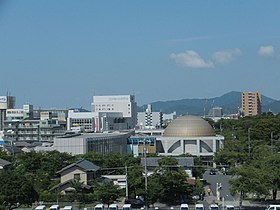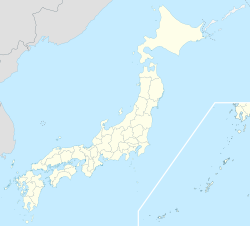Toyokawa, Aichi
Toyokawa
豊川市 | |||||||
|---|---|---|---|---|---|---|---|
    
| |||||||
 Flag  Seal | |||||||
 Location of Toyokawa in Aichi Prefecture, highlighted in pink | |||||||
 | |||||||
 Toyokawa | |||||||
| Coordinates: 34°49′36.4″N 137°22′33.3″E / 34.826778°N 137.375917°ECoordinates: 34°49′36.4″N 137°22′33.3″E / 34.826778°N 137.375917°E | |||||||
| Country | Japan | ||||||
| Region | Chūbu (Tōkai) | ||||||
| Prefecture | Aichi | ||||||
| First official recorded | 480 AD | ||||||
| City Settled | June 1, 1943 | ||||||
| Government | |||||||
| • Mayor | Minoru Yamawaki | ||||||
| Area | |||||||
| • Total | 161.14 km2 (62.22 sq mi) | ||||||
| Population (October 1, 2019) | |||||||
| • Total | 183,930 | ||||||
| • Density | 1,100/km2 (3,000/sq mi) | ||||||
| Time zone | UTC+9 (Japan Standard Time) | ||||||
| - Tree | Japanese Black Pine | ||||||
| - Flower | Dwarf azalea | ||||||
| Phone number | 0533-89-2111 | ||||||
| Address | 1-1 Suwa-chō, Toyokawa-shi, Aichi-ken 442-0068 | ||||||
| Website | Official website | ||||||
Toyokawa (豊川市, Toyokawa-shi) is a city located in the eastern part of Aichi Prefecture, Japan. As of 1 October 2019, the city had an estimated population of 183,930 in 72,949 households,[1] and a population density of 1,141 persons per km². The total area of the city is 161.14 square kilometres (62.22 sq mi). Toyokawa, famous for its Toyokawa Inari temple, is blessed with a good balance of industry, commerce, agriculture and forestry, and is situated in an area rich in history, traditions, and culture.
Geography[]
Toyokawa is located in an area of rolling hills in southeastern Aichi Prefecture. It has a short coastline with Mikawa Bay.
Climate[]
The city has a climate characterized by hot and humid summers, and relatively mild winters (Köppen climate classification Cfa). The average annual temperature in Toyokawa is 15.8 °C. The average annual rainfall is 1751 mm with September as the wettest month. The temperatures are highest on average in August, at around 27.5 °C, and lowest in January, at around 4.8 °C.[2]
Demographics[]
Per Japanese census data,[3] the population of Toyokawa has been increasing over the past 60 years.
| Year | Pop. | ±% |
|---|---|---|
| 1950 | 98,332 | — |
| 1960 | 105,590 | +7.4% |
| 1970 | 130,997 | +24.1% |
| 1980 | 157,084 | +19.9% |
| 1990 | 168,796 | +7.5% |
| 2000 | 176,698 | +4.7% |
| 2010 | 181,882 | +2.9% |
Surrounding municipalities[]
History[]
Origins[]
The area of modern Toyokawa was settled in prehistoric times. During the Nara period, the kokubunji of Mikawa Province was established in 741.
Muromachi Period[]
The temple of Toyokawa Inari, a popular pilgrimage destination, dates from 1441.
Sengoku Period[]
A number of daimyō clans under the Tokugawa shogunate originate in what are now parts of Toyokawa, most notably the Makino clan.
Edo Period[]
The area prospered during the Edo period with two post towns along the Tōkaidō, Goyu-shuku and Akasaka.
Meiji Period[]
After the Meiji Restoration, on October 1, 1889 several villages were organized with the establishment of the modern municipalities system within Hoi District, Aichi Prefecture, including Toyokawa Village. On March 13, 1893, Toyokawa was promoted to town status.
Showa Period[]
Toyokawa City was founded on June 1, 1943 by the merger of Toyokawa town with neighboring Ushikubo Town and Yawata Village, all from Hoi District.
In 1939 the massive Toyokawa Naval Arsenal was established, one of the largest producers of machine guns, aviation ordnance and ammunition in the Empire of Japan. It was also had sections that produced military-issue katana, bayonets, and glass lenses for use in cameras, binoculars, and similar equipment. During World War II, many thousands of civilians were conscripted or volunteered to work at the Arsenal, and towards the end of the war, included hundreds of middle school students and high school girls. On August 7, 1945 the Toyokawa Naval Arsenal was targeted by a flight of B-29 bombers. About 2,500 people were killed during the Toyokawa Air Raid.
Toyokawa was one of the last places to be targeted using conventional explosive and incendiary bombs in the closing days of World War II, occurring the day after Hiroshima was destroyed by an atomic bomb.[4]
After WWⅡ[]
After the war, on April 12, 1955 Toyokawa annexed Mikami village from . This was followed by the neighboring town of Goyu from Hoi District on April 1, 1959. Toyokawa further expanded on February 1, 2006 by annexing Ichinomiya, On January 15, 2008 the towns of Otowa and Mito became part of Toyokawa, and finally on February 1, 2010 the town of Kozakai likewise was merged into Toyokawa City.

Ina Castle

Toyokawa Tezutsu Fireworks Festival

Memorial to the victims of the Toyokawa Air Raid
Government[]

Toyokawa has a mayor-council form of government with a directly elected mayor and a unicameral city legislature of 30 members. The city contributes one member to the Aichi Prefectural Assembly. In terms of national politics, the city is part of Aichi District 8 of the lower house of the Diet of Japan.
Military facilities[]
International relations[]
Twin towns/sister cities[]
- Sister cities
 Wuxi New Area, China.[5]
Wuxi New Area, China.[5] Santa Rosa, Laguna, Philippines
Santa Rosa, Laguna, Philippines Cupertino, California, United States[6]
Cupertino, California, United States[6]
Education[]
Toyokawa has 26 public elementary schools and 10 public junior high schools operated by the city government, and five public high schools operated by the Aichi Prefectural Board of Education. There is also one private high school. The prefecture also operates one special education school for the handicapped.
Transportation[]
Railways[]
Conventional lines[]
- Tōkaidō Main Line:Nishi-Kozakai • Aichi-Mito
- Iida Line:Kozakai • Ushikubo • Toyokawa • Mikawa-Ichinomiya • Nagayama • Ejima • Tōjō •
- Toyokawa Line:Kō • Yawata • Suwachō • Inariguchi • Toyokawa-Inari
- Nagoya Main Line:Ina - Odabuchi - Kō - Goyu - Meiden-Akasaka - Meiden-Nagasawa
Roads[]
Highway[]
Japan National Route[]
Seaways[]
Sea port[]
- Port of Mito(Port of Mikawa)
Local attractions[]

- Castles
- Ina Castle
- Makino Castle
- Ushikubo Castle
- Temples
- Toyokawa Inari – noted Buddhist temple
- Mikawa Kokubun-ji
- Shrines
- Toga Shrine - ichinomiya of Mikawa Province
Notable people from Toyokawa[]

This section does not cite any sources. (April 2014) |
- Atsuya Ota, Basketball player
- Yuka Kato, Olympic swimmer
- Gakuto Kondo, professional soccer player
- Masahiko Morifuku, Baseball player
- Sion Sono, movie director
- Yukinari Sugawara, professional soccer player
- Yamamoto Kansuke, JapaneseSamurai of the Sengoku period
- Yusuke Yamamoto, Japanese Actor
References[]
- ^ Toyokawa City official statistics (in Japanese)
- ^ Toyokawa climate data
- ^ Toyokawa population statistics
- ^ Air War Pacific Chronology: America's Air War Against Japan in East Asia and the Pacific 1941-1945 by Eric Hammel, (Pacifica, CA: Pacifica Press, 1988, ISBN 0-935553-26-6)
- ^ "International Exchange". List of Affiliation Partners within Prefectures. Council of Local Authorities for International Relations (CLAIR). Archived from the original on 24 December 2015. Retrieved 21 November 2015.
- ^ "豊川市 姉妹都市キュパティーノ市".
External links[]
- Official website
 (in Japanese)
(in Japanese)  Geographic data related to Toyokawa, Aichi at OpenStreetMap
Geographic data related to Toyokawa, Aichi at OpenStreetMap
| Wikimedia Commons has media related to Toyokawa, Aichi. |
- Toyokawa, Aichi
- Cities in Aichi Prefecture
- Populated coastal places in Japan









